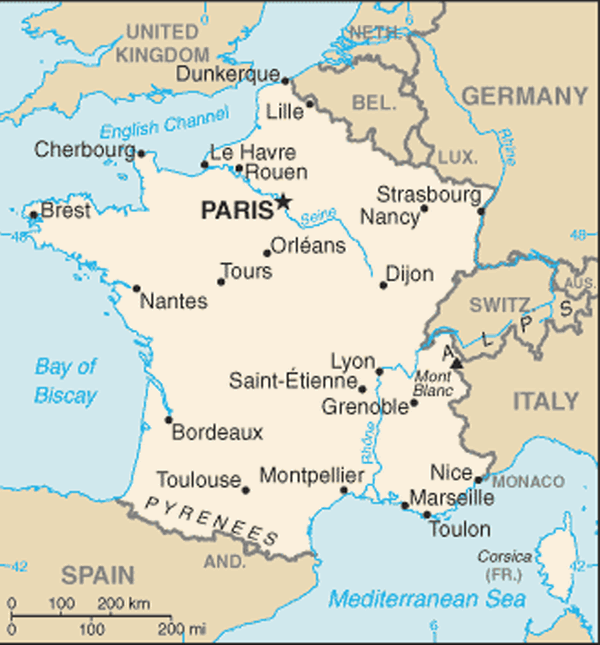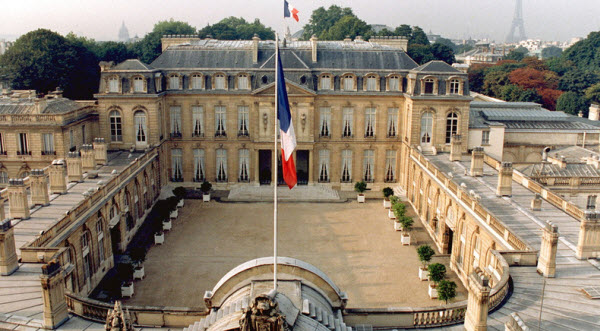France, officially known as the French Republic, is a country located in Western Europe with a rich history that spans from ancient times to the present. It is known for its cultural heritage, historical influence, and significant role in global affairs.
Geography

- Location: Western Europe, bordering Belgium, Luxembourg, Germany, Switzerland, Italy, Spain, and Andorra; also has maritime borders with the United Kingdom.
- Coordinates: Approximately 46.6034° N, 1.8883° E.
- Area: Approximately 551,695 square kilometers.
- Borders:
- France shares land borders with Belgium (650 km), Luxembourg (73 km), Germany (451 km), Switzerland (573 km), Italy (488 km), Spain (623 km), Andorra (56 km), and Monaco (4.4 km).
- Climate:
- Varies from oceanic in the west to continental in the east, and Mediterranean in the south. The climate is generally temperate with mild winters and warm summers.
- Terrain:
- Varied, including mountain ranges such as the Alps and Pyrenees, fertile plains, and rolling hills.
- Elevation:
- The lowest point is the Rhone River delta (0 m), and the highest point is Mont Blanc (4,808 m).
- Natural Resources:
- Coal, iron ore, bauxite, uranium, and limestone. The country also has significant agricultural resources and maritime resources.
- Land Use:
- Arable land: approximately 33%, permanent crops: 4%, other: 63%.
- Population Distribution:
- The population is concentrated in major cities and metropolitan areas, with a significant urban population in Paris and its surrounding regions.
Population and Society

- Population: Approximately 67 million (estimate for 2024).
- Ethnic Groups:
- Primarily ethnic French, with notable communities of immigrants from North Africa, sub-Saharan Africa, and other European countries.
- Languages:
- The official language is French. Regional languages such as Breton, Alsatian, and Occitan are also spoken.
- Religions:
- Predominantly secular, with significant Christian (mainly Roman Catholic) presence; also includes Jewish, Muslim, and Buddhist communities.
- Age Structure:
- The population has a balanced age structure with an aging population due to increased life expectancy and lower birth rates.
- Population Growth Rate:
- Approximately 0.4% per year.
Country

- Country Name: French Republic
- Common Name: France
- Origin of Name: Derived from the Latin name “Francia,” which means “Land of the Franks,” a Germanic tribe that settled in the region.
- Type of Government: Semi-presidential republic.
- Capital: Paris
- Origin of Capital Name: Paris is named after the Parisii, a Celtic tribe that settled the area.
- Local Time: Central European Time (CET) (UTC+1); Central European Summer Time (CEST) (UTC+2) during daylight saving time.
- Daylight Saving Time: Observed from the last Sunday in March to the last Sunday in October.
- Administrative Divisions: 13 metropolitan regions and 5 overseas regions.
- Dependent Areas: French Polynesia, New Caledonia, and several other overseas territories.
- Independence: Established as a republic in 1789 after the French Revolution.
- Citizenship Acquisition: By birth, descent, or naturalization.
- Legal System: Civil law system based on written codes, influenced by Napoleonic Code.
- Executive Branch: The President is the head of state, and the Prime Minister is the head of government.
- Legislative Branch: Bicameral Parliament consisting of the National Assembly and the Senate.
- Judicial Branch: The Court of Cassation is the highest court in France.
- Political Parties: Includes major parties like La République En Marche!, The Republicans, Socialist Party, National Rally, and others.
- Flag Description: Three vertical stripes of blue, white, and red from left to right.
- Country Code: FRA
Economy
- GDP: Approximately 3.1 trillion USD.
- Agricultural and Animal Products: Wheat, barley, corn, wine, cheese, dairy products, pork, poultry.
- Industries: Aerospace, automotive, electronics, pharmaceuticals, machinery, chemicals, textiles, food processing, tourism.
- Budget: Balanced with occasional surpluses and deficits.
- Exports: Machinery, aircraft, pharmaceuticals, chemicals, cosmetics, wine, and food products.
- Imports: Machinery, aircraft, crude oil, chemicals, automotive products, foodstuffs.
- Foreign Reserves: Approximately 200 billion USD.
- External Debt: Approximately 2.5 trillion USD.
- Local Currency: Euro (EUR).
Communications
- Fixed Lines: Approximately 35 million lines.
- Mobile Lines: Approximately 75 million lines.
- Country Code: +33
- Broadcast Media: France Télévisions, Radio France, and numerous private media outlets.
- Internet Code: .fr
- Internet Users: Approximately 60 million people.
Transport

- National Air Transport System: Extensive network with many international and domestic airports.
- Airports: Over 200 airports.
- Heliports: Numerous, mainly in urban and industrial areas.
- Pipelines: Extensive network for oil, gas, and chemicals.
- Railways: Extensive network with high-speed trains (TGV) and regional lines.
- Road Network: Includes highways and major roads totaling approximately 1 million kilometers.
- Ports: Major ports include Le Havre, Marseille, and Dunkirk.
Military

- Military Composition: Includes the French Army, French Navy, French Air and Space Force, and French Gendarmerie.
- Military Expenditures: Approximately 60 billion USD per year.
- Personnel in Military and Security Services: Approximately 300,000 active members.
- Military Equipment: Includes advanced fighter jets, aircraft carriers, submarines, tanks, and missiles.
- Military Service Age: 18 years for compulsory military service (volunteer basis currently).
